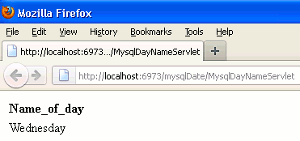In this tutorial you will learn about how to use mysql dayname() function in Java Servlet.
MySql DAYNAME() Function Example using Java Servlet
In this tutorial you will learn about how to use mysql dayname() function in Java Servlet.
DAYNAME() function of mysql gives the week day name of a particular date and returns 'null' if you will entered the incorrect date. Name of day will be (SUNDAY, MONDAY, TUESDAY, WEDNESDAY, THURSDAY, FRIDAY, SATURDAY).
Syntax of dayname() function :
dayname(date);
Here the parameter 'date' is a date(yyyy-mm-dd).
Now, since I have to use this function in java servlet program, therefore I have created a java servlet class named MysqlDayNameServlet which extends the HttpServlet class. In the body of class I overridden the method doGet() and created an objects of HttpServletRequest and HttpServletResponse into its parameter. Inside the doGet() method first I set the mime type that in which format the browser will show the output. In the next line I used the getWriter() method of ServletResponse interface with the object of HttpServletResponse. HttpServletResponse interface extends this method from the ServletResponse. In continue we have to make a connection between java code and database system. So, since I am using Mysql in the example given below therefore, I am loading the driver of mysql and make a connection by using the getConnection() method of DriverManager class. It returns a Connection. Further I am passing the query "SELECT DAYNAME('2011-08-03') as Name_of_day;" (This query will return the week day name(wednesday) from the date (2011-08-03) ) into the parameter of prepareStatement() method of Connection interface which gives an object of PreparedStatement interface. In the next line I used the executeQuery() method of PreparedStatement interface which returns a ResultSet object that holds the result of query. At last I have extracted the result from the ResultSet object.
Example :
MysqlDayNameServlet.java
import java.io.IOException;
import java.io.PrintWriter;
import java.sql.SQLException;
import java.sql.Connection;
import java.sql.PreparedStatement;
import java.sql.ResultSet;
import java.sql.DriverManager;
import javax.servlet.ServletException;
import javax.servlet.http.HttpServlet;
import javax.servlet.http.HttpServletRequest;
import javax.servlet.http.HttpServletResponse;
public class MysqlDayNameServlet extends HttpServlet
{
public void doGet(HttpServletRequest req, HttpServletResponse res)
throws IOException, ServletException
{
res.setContentType("text/html");
PrintWriter pw = res.getWriter();
String className = "com.mysql.jdbc.Driver";
String url = "jdbc:mysql://192.168.10.13/data";
String user = "root";
String password = "root";
String sql = "SELECT DAYNAME('2011-08-03') as Name_of_day;";
Connection con;
PreparedStatement ps;
ResultSet rs;
try
{
Class.forName(className);
con = DriverManager.getConnection(url,user,password);
ps = con.prepareStatement(sql);
rs = ps.executeQuery();
pw.println("<table><tr>");
pw.println("<td><b>Name_of_day</b></td>");
pw.println("</tr>");
while(rs.next())
{
String dayName = rs.getString("Name_of_day");
pw.println("<tr>");
pw.println("<td>"+dayName+"</td>");
pw.println("</tr>");
}
pw.println("</table>");
}
catch(SQLException sx)
{
pw.println(sx);
}
catch(ClassNotFoundException cx)
{
pw.println(cx);
}
}
}
web.xml
<?xml version="1.0" encoding="UTF-8"?>
<web-app id="WebApp_ID" version="2.4" xmlns="http://java.sun.com/xml/ns/j2ee" xmlns:xsi="http://www.w3.org/2001/XMLSchema-instance" xsi:schemaLocation="http://java.sun.com/xml/ns/j2ee http://java.sun.com/xml/ns/j2ee/web-app_2_4.xsd">
<display-name>mysqlDate</display-name>
<servlet>
<servlet-name>MysqlDayNameServlet</servlet-name>
<servlet-class>MysqlDayNameServlet</servlet-class>
</servlet>
<servlet-mapping>
<servlet-name>MysqlDayNameServlet</servlet-name>
<url-pattern>/MysqlDayNameServlet</url-pattern>
</servlet-mapping>
</web-app>
Output :
When you will execute the above example you get the output as :



[ 0 ] Comments